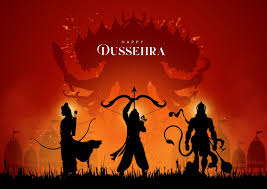The Triumph of Good Over Evil
Introduction
Dussehra, also known as Vijayadashami, is one of the most significant Hindu festivals celebrated across India. It marks the victory of Lord Rama over the demon king Ravana and symbolizes the triumph of good over evil. Falling at the end of Navratri, Dussehra usually occurs in September or October.

Mythological Significance
The festival finds its roots in the epic Ramayana, where Lord Rama defeats Ravana to rescue his wife, Sita. Ravana, a powerful king with ten heads, symbolizes ego and evil. Dussehra celebrates the destruction of this evil and the restoration of dharma (righteousness).
In eastern India, especially in West Bengal, Dussehra coincides with Durga Puja, which celebrates Goddess Durga’s victory over the buffalo demon Mahishasura.
Celebrations Across India
Dussehra is celebrated in unique ways across different states:
- North India: Huge effigies of Ravana, Meghnath, and Kumbhkaran are burned in open grounds amidst fireworks, reenacting the Ramayana scenes in “Ramlila” plays.
- South India: People decorate their homes and temples, and worship instruments, books, and tools as a sign of respect during Ayudha Puja.
- West Bengal & East India: The festival marks the end of Durga Puja, and idols of Goddess Durga are immersed in water bodies with great processions.
Cultural and Social Impact
Beyond religious significance, Dussehra spreads the message of truth, justice, and moral values. Schools, offices, and communities organize plays, fairs, and cultural programs. It brings families and friends together, encouraging unity and happiness.

Leave a Reply